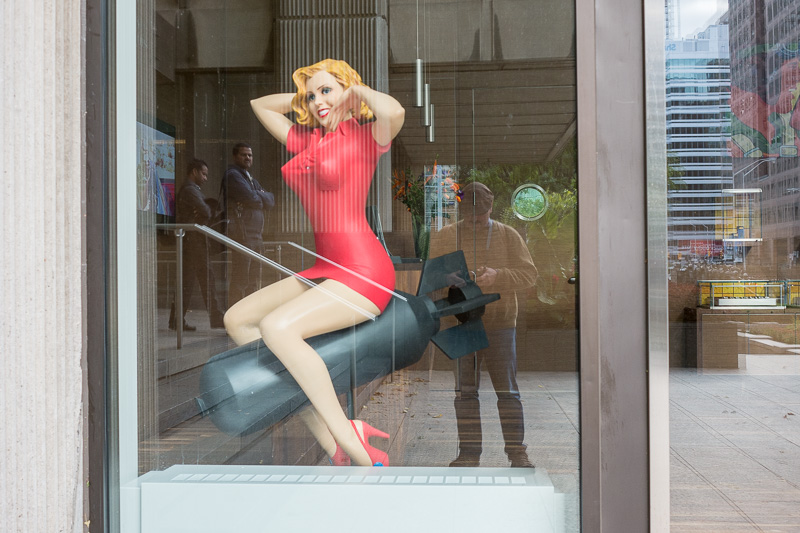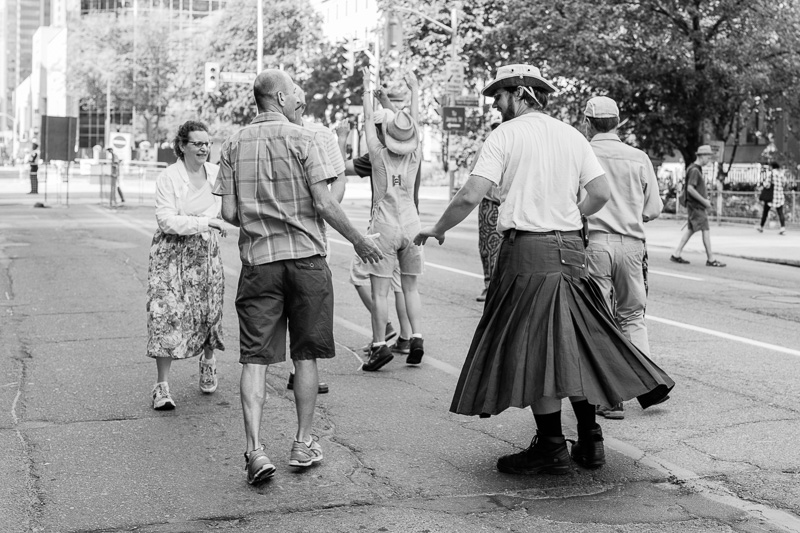The Swiss watch manufacturer, Breitling, has opened its official Canadian distribution headquarters at 250 Bloor St. E. I wouldn’t have noticed except for the bombshell sitting in the front window and blazing red in the late afternoon sunlight. They’ve propped up a life-sized, or somewhat (ahem) larger-than-life, mannikin of a blond woman in a red dress and riding a bombshell in much the same way as Slim Pickens rode the H-bomb to his doom in Dr. Strangelove. I wouldn’t have cared except the question kept nagging me: what does this have to do with watches?

It would seem that Breitling has a long history of producing precision chronometers for the aviation industry. Read: military. They’re proud of their history. It’s part of their branding. Their online commercial features another bombshell leaning into a cockpit and waving her ass at the camera. The whole thing—lipstick, hairdo, pilot’s chiseled jawline—evokes an earlier time, a simpler time. Men were men and women were accessories. The West was free and its enemies were easy to recognize.
Did I mention that Breitling manufactures men’s watches? Its branding appeals to a masculine sensibility. Or at least a straight masculine sensibility. It’s important to underscore the straight part of that sensibility given that the headquarters sit roughly at the north end of the Village.
So, when a company decides to brand for a (straight) masculine sensibility, how do its marketing people proceed? Do they begin by researching masculinity? Do they press their fingers to the manly pulse of the times? What would they learn if they did?

At this very instant, Toronto is in the throes (or is it throws?) of baseball fever. The series with the Texas Rangers is tied at two games apiece. Giant men who can whack balls unbelievable distances for eight-figure salaries will gather on Wednesday to decide which club moves on in its quest for something that, two hundred years from now, no one will remember. Meanwhile men will drink beer and yell and watch TV in bars if they can’t afford tickets to the game. When it’s over, they’ll pour into the streets and yell and honk car horns and throw bottles. That’s what men do.
As if that weren’t enough, at this very instant, our entire country is in the throes of election fever. If I were some kind of cultural studies academic, I’d write a thesis drawing a connection between Breitling’s marketing campaign and the Conservative election campaign. The point of connection would be masculinity, of course.
I would be willing to test a thesis on these terms: the portrayal (and manipulation) of masculinity is the Conservative Party’s primary function, at least as it has been revisioned by Stephen Harper. We see this in trivial points, like poking fun at Justin Trudeau for his youthful good looks and his naturally wavy hair. More perniciously, we see this in Harper’s strategy of distraction: the niqab thing. Women who hide themselves must have more than just themselves to hide. Maybe underneath all those garments they’re hiding bombs between their legs. In the West, our women are open about the bombs they hold between their legs. But the narrative that imagines freedom in these terms could only have been constructed by a straight (white) man. I’ll flesh out the details when I actually write my thesis, but I’m sure you get the gist.
Same thing when it comes to economic policy. Economics is a very masculine concern. It’s about job creation. You know, jobs? Those things men have so they can keep their women? By the way, accountancy isn’t a real job. A job isn’t a real job unless it makes you break into a sweat at least once a day, not just in April. A job is even more real if it lets you contribute to environmental destruction while you’re breaking your sweat.
As for the arts … fuck the arts. Real men don’t do arts. They do their important stuff, contribute to the economy, drive their cars with the top down, and every now and then as the breeze is blowing through their naturally wavy hair, they look at their precision chronometers.
